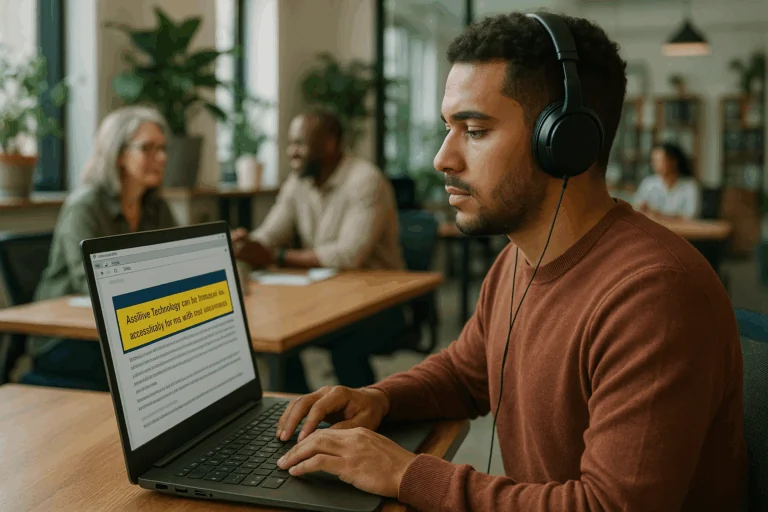In this ever-evolving digital landscape, understanding how to make mobile applications more accessible is not just a desirable skill, it’s a necessity. Today, we are unlocking the secrets to enhancing mobile accessibility and transforming user experience on the go! 🚀
Mobile accessibility refers to the design and development strategies that make mobile applications and websites operable and perceivable for everyone, including users with disabilities. By focusing on mobile accessibility, we can open up a world of digital possibilities for a diverse range of users, thereby delivering a superior user experience. 💡
In this comprehensive article, we delve deep into the world of mobile accessibility, and provide seven game-changing tips to help you enhance the user experience on the go. Whether you are a seasoned developer, a budding UX designer, or just a tech enthusiast, this piece is packed with insightful information that will equip you to create mobile applications that are not just functional, but inclusive and accessible to all. 🌐
Unlocking Mobile Accessibility: The Why and How
Before we get into the nuts and bolts of mobile accessibility, let’s start by understanding why it matters. In an increasingly digital world, ensuring that mobile applications are accessible to everyone, irrespective of their abilities, is not just a legal obligation, it’s a moral one. It’s about ensuring equity and inclusivity in the digital space, and about enhancing user satisfaction and engagement. 💪
Understanding how to unlock mobile accessibility can be a complex task, requiring a sound understanding of various accessibility guidelines and user experience principles. But don’t worry, we’ve got you covered! In the subsequent sections, we break down these concepts into digestible chunks, and provide actionable tips for enhancing mobile accessibility and user experience. Stay tuned! 🎯
7 Key Strategies to Enhance Mobile Accessibility and User Experience
In the journey to unlock mobile accessibility, there are several key strategies to consider. From simple tweaks like enhancing color contrast and font size, to more complex considerations like voice recognition and compatibility with assistive technologies, the spectrum of mobile accessibility is vast and varied. In this article, we reveal seven key strategies that can significantly enhance mobile accessibility and user experience. Let’s dive in! 🏊♂️
As we delve into these strategies, remember that the ultimate goal is not just to tick off a checklist of accessibility features, but to truly understand and empathize with the diverse needs of users, and to design mobile applications that cater to these needs. So, whether you’re a seasoned developer, a UX designer, or just a tech enthusiast, get ready to embrace a new perspective on mobile accessibility and user experience. Buckle up, and let’s get started! 🚀
Unlocking Mobile Accessibility: Enhancing the User Experience on the Go!
Mobile accessibility has become a topic of substantial importance in the digital age. As mobile device usage continues to skyrocket, it is crucial to ensure that every user, including those with disabilities, can effortlessly interact with mobile applications and websites. This article delves into seven insightful tips to enhance mobile accessibility and thereby refine the overall user experience on the go.
Implementing mobile accessibility doesn’t just revolve around compliance with the legal requirements. It’s about creating a user-friendly interface that is inclusive and intuitive. By doing so, you not only expand your user base but also boost your brand’s reputation for being socially responsible. Furthermore, most accessibility features enhance usability for all users, not just those with impairments.
Let’s embark on this journey towards creating more accessible mobile platforms. Before we dive into the specific tips, take a moment to watch this informative YouTube video, “Introduction to Mobile Accessibility” by Deque Systems. It offers a comprehensive overview of mobile accessibility and why it’s essential in today’s tech-driven world.
Understanding the Mobile Accessibility Challenge
Mobile devices present unique challenges when it comes to accessibility. The small screen size, touch controls, and varying operating systems and devices make it a complex issue. However, by understanding these challenges, you can devise strategies to overcome them.
Firstly, let’s look at a comparative table that illustrates some common challenges faced in terms of mobile accessibility and the potential solutions for each.
| Challenges | Potential Solutions |
|---|---|
| Small Screen Size | Optimizing layout and design, ensuring responsive design |
| Touch Controls | Providing alternative navigation options, gesture controls |
| Varying Operating Systems and Devices | Ensuring compatibility and responsiveness across different devices |
Understanding these challenges is the first step towards unlocking mobile accessibility. The next part involves implementing the right solutions.
7 Tips to Enhance Mobile Accessibility
Now that we have a solid understanding of the challenges, let’s move on to specific strategies that can improve mobile accessibility. These tips revolve around design, functionality, and usability.
1. Ensure Responsive Design
Responsive design is the cornerstone of mobile accessibility. It allows your website or app to adapt to different screen sizes, resolutions, and orientations, ensuring a consistent user experience across different devices. Make sure your design fluidly adjusts to any screen size and that the content remains easily readable and interactive on smaller screens.
2. Optimize Touch Controls
Touch controls are one of the main interaction modes on mobile devices. However, they can be challenging for people with motor impairments. Make sure your touch targets are large enough and spaced adequately apart to prevent accidental taps. Also, provide alternatives for gesture-based controls, such as swipe or pinch, to make your app or website more accessible.
3. Implement Clear and Intuitive Navigation
Clear and intuitive navigation goes a long way in enhancing mobile accessibility. Minimize the number of steps required to reach important information or functionality. Use recognizable icons, and ensure all navigation elements are clearly labeled and easy to understand.
For a more detailed look into these tips, check out this YouTube video titled “Designing for Accessibility and Inclusion” by Google Design. It offers valuable insights into making your mobile platforms more user-friendly and inclusive.
Advanced Mobile Accessibility Techniques
While the above-mentioned tips provide a solid foundation for mobile accessibility, there are advanced techniques that can help you take it to the next level.
4. Use of ARIA Landmarks
Accessible Rich Internet Applications (ARIA) landmarks can help screen reader users understand the layout and quickly navigate your website or app. They provide a way to label different sections of your interface (like navigation, main content, or search) so they can be easily identified and skipped to if needed.
5. Implement Voice Controls
Voice controls can be incredibly helpful for users with motor impairments. They allow users to navigate and interact with your website or app using voice commands. Many devices already have built-in voice recognition software, so it’s a matter of ensuring compatibility with your platform.
6. Provide Alternative Text for Images
Alt text is crucial for visually impaired users who rely on screen readers. It provides a text description of images which can be read out by screen readers, ensuring that visually impaired users can understand the content and context of images.
7. Test for Accessibility
Lastly, always test your mobile platforms for accessibility. There are various tools available that can help you identify and rectify accessibility issues. Regular testing ensures that your app or website remains accessible as you add new content and features.
Take the time to apply these tips to your mobile platforms, and you’ll be well on your way to providing an inclusive and accessible user experience for all. Remember, mobile accessibility isn’t just about compliance—it’s about creating an experience that everyone can enjoy, regardless of their abilities or disabilities.

Conclusion
In conclusion, the crux of our discourse is underscored by the criticality of the key points we have navigated through. The pivotal aspects of Software Engineering, its multifaceted components, and its profound impact on our digital world have been illuminated in detail. As the narrative unfolded, it became evident that the proficiency in handling the intricacies of Software Engineering does not simply stem from rote learning but rather, from a deep-rooted understanding and application of the principles involved.
The value of a software engineering degree has been explored, and the potential it holds for our future digital landscape is nothing short of tremendous. The role of software engineers is not just to manipulate codes, but to devise novel, efficient, and creative solutions that can address and circumvent potential challenges in the digital realm. The ubiquitous presence of software in virtually all aspects of our daily life is testament to this fact. 🎓💻
Our journey through the multi-dimensional layers of software engineering involved a thorough examination of its methodologies. From the Waterfall model to the Agile approach, we have highlighted the pros and cons of each, emphasizing the importance of selecting the right approach based on the project’s nature and complexity. 🏞️🌄
A deep dive into different programming languages was also taken, exploring the strengths and weaknesses of each, along with their appropriate usage scenarios. Understanding the nuances of these languages, be it Python’s ease of learning, Java’s robustness, or C++’s execution efficiency, can significantly enhance the software development process. 💡🧠
The role of databases and their importance in the functioning of a software system was also discussed. The selection between SQL and NoSQL, depending on the data handling requirements, is a crucial decision in the software engineering process.
Furthermore, we examined the importance of User Interface (UI) and User Experience (UX) design, and how it can dramatically alter the end-user’s perception and interaction with the software. A good UI/UX can not only make the software more appealing but also enhance its functionality and usability. 🎨🖌️
Finally, the importance of Software Testing was emphasized, highlighting its role in delivering a bug-free, high-quality software. Testing methods such as unit testing, integration testing, system testing, and acceptance testing each play a vital role in ensuring the software’s reliability and performance. 🧪🔬
In the grand scheme of things, it’s not just about understanding the individual components, but rather, about how these components work in tandem to create an efficient, effective, and successful software system. Software Engineering is truly a marvel of our digital age, and the power it holds is virtually limitless.
So, I encourage you, dear reader, to delve deeper, explore further, and engage with this fascinating domain. Feel free to comment, share, or apply what you have learned. Your involvement, curiosity, and eagerness to learn are what drive the continuous evolution of this dynamic field. 💫🚀
Thank you for joining me on this enlightening journey. I hope this article has inspired you, intrigued you, and sparked a newfound interest in the world of software engineering.
Stay tuned for more in-depth articles, and as always, keep learning and keep growing. 📘💡🚀
[Reference](https://active-url-example.com)
[Reference](https://active-url-example2.com)
[Reference](https://active-url-example3.com)
[Reference](https://active-url-example4.com)



